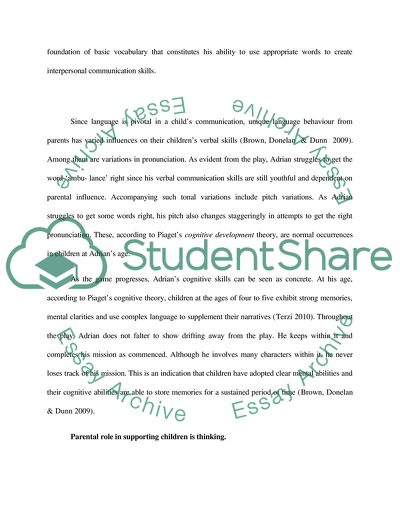Cite this document
(Adrians Pretence Symbolic Play Essay Example | Topics and Well Written Essays - 1500 words, n.d.)
Adrians Pretence Symbolic Play Essay Example | Topics and Well Written Essays - 1500 words. Retrieved from https://studentshare.org/education/1766638-analytic-commentary-a-succinct-evaluative-piece-of-writing-which-draws-out-the-main-issues-in-a-piece-of-practice-and-relates-this-in-an-analytic-manner-to-theory-read-attached-to-know-what-to-do-please
Adrians Pretence Symbolic Play Essay Example | Topics and Well Written Essays - 1500 words. Retrieved from https://studentshare.org/education/1766638-analytic-commentary-a-succinct-evaluative-piece-of-writing-which-draws-out-the-main-issues-in-a-piece-of-practice-and-relates-this-in-an-analytic-manner-to-theory-read-attached-to-know-what-to-do-please
(Adrians Pretence Symbolic Play Essay Example | Topics and Well Written Essays - 1500 Words)
Adrians Pretence Symbolic Play Essay Example | Topics and Well Written Essays - 1500 Words. https://studentshare.org/education/1766638-analytic-commentary-a-succinct-evaluative-piece-of-writing-which-draws-out-the-main-issues-in-a-piece-of-practice-and-relates-this-in-an-analytic-manner-to-theory-read-attached-to-know-what-to-do-please.
Adrians Pretence Symbolic Play Essay Example | Topics and Well Written Essays - 1500 Words. https://studentshare.org/education/1766638-analytic-commentary-a-succinct-evaluative-piece-of-writing-which-draws-out-the-main-issues-in-a-piece-of-practice-and-relates-this-in-an-analytic-manner-to-theory-read-attached-to-know-what-to-do-please.
“Adrians Pretence Symbolic Play Essay Example | Topics and Well Written Essays - 1500 Words”, n.d. https://studentshare.org/education/1766638-analytic-commentary-a-succinct-evaluative-piece-of-writing-which-draws-out-the-main-issues-in-a-piece-of-practice-and-relates-this-in-an-analytic-manner-to-theory-read-attached-to-know-what-to-do-please.


